What to do if Benjamin's ficus has dropped all the leaves?
Favorite of florists ficus benjamin is represented by almost every collector of indoor plants. It is loved for its ease of care, excellent decorative properties and the ability to shape both the trunk and the crown. But improper care leads to the fact that the plant completely discards its foliage and it threatens to move to the nearest trash heap. But there is no need to rush into this, as there are many ways to help the flower regain its former shining appearance.
Content:
- General information about ficus
- Ficus dropped the leaves? Looking for a reason
- How to help a ficus, if, after all, the leaves have fallen?
- Helpful tips: how to properly care for a plant
General information about ficus
Varieties ficus quite a lot, but the structural features of Benjamin's ficus are as follows:
- it has a straight shoot, and the stem is round
- crown branched
- leaf blades are smooth, slight bending is allowed. The skin is thin, the leaf is oblong and oval, ending in a pointed tip. The dimensions of the plate are approximately from 5 to 14 cm, its width is from 3 to 7 cm.
- the arrangement of the plates on the branches is next
- petiole from 0.5 to 2 cm.
- root system well developed
- gray bark
If you initially create good conditions for the plant, then there will be no problems with the plant:
- the ambient temperature must correspond to the climatic season. In winter, ficus is kept at a temperature of 15 to 22 C, in summer 24-29 C.
- watering must be done as the upper earthen crust dries. The water must be removed from the pallet. The water must be at least 14 C, otherwise the soil will overcool and all processes will slow down
- especially variegated varieties need a good light source
- spraying is carried out only in the absence of drafts and soft, settled water. You can add special sugar for plants or sometimes fungicides
Ficus dropped the leaves? Looking for a reason
Despite the fact that the ficus is not as capricious as many pets that need similar conditions, but with improper care, the ficus sheds its leaves and it is quite difficult to restore rich hair later.
There are some factors that directly affect a plant shedding foliage:
- The first reason is drafts. Ficus Benjamin categorically does not tolerate even the slightest sharp fluctuations in temperature. Although airing the room where the flowers are located is only welcome. There is a big difference between when the room is deliberately ventilated or when the flower stands in places where there are constant changes in temperature. That is, a large area of the plant and its roots are in the same temperature regime, and some part is cooled. Of course, in such places the intake of nutrients slows down, when, like in the rest of the plant, nutrition is consumed at the same level. The immune system of the flower receives a signal that a disease is developing in some area and potentially diseased branches begin to die off. Ficus forms new branches, and the area standing in the through wind begins to die off. So if the ficus leaves only a few branches fall, then the cause is drafts.
- Lack of nutrition also has a detrimental effect on foliage and the general condition of plants. Ficus must be fed from early spring to late autumn. Ficus Benjamin is a large plant and, under favorable conditions, it develops well, therefore, the lack of necessary trace elements and substances that are needed for the further growth of the tree leads to depletion. The leaves first become faded and lethargic, and then, weakening, fall off.
- Compulsory spraying. Excessive dryness of the air affects the ficus not only by the fact that abundant leaf fall begins, but also by the fact that a scale insect is attached without special obstacles, which is extremely difficult to get rid of. Ficus native to humid tropical places, and the system of water consumption is designed in such a way that the plant also feeds on water through the leaves, in a larger volume than all others. Therefore, if you deprive it of a humid environment, then the ficus will begin to lose leaves in a much larger volume than is laid down by nature.
And there are also other reasons why such a problem occurs:
- insufficient lighting, but it's easy to fix if you periodically add light phytolamps
- must be checked for diseases and pests
- this can happen if the ficus has changed its place of residence or when transplanted into another pot
But do not confuse abundant leaf fall with natural leaf fall, since each leaf lives for about three years, and then dying off occurs. Old leaf plates are harder and darker than young ones, so if periodically a florist finds them on the floor, then this is not scary.
How to help a ficus, if, after all, the leaves have fallen?
Helping the plant should be reasonable. Because if you take active measures during the period of biological hibernation, you can seriously harm the ficus. Therefore, if such a nuisance began to take place in the autumn-winter period, when the feeding season has already ended, then the following measures can be taken:
- add some fresh soil, but not fertilizer
- spray the plant several times a day
- put an additional light source
- eliminate all through wind access
Such precautions will help slow down the process of suppression of the vital functions of the ficus, and prepare it for intensive therapy in the spring and summer.
Already at the end of March, the ficus must be transplanted into a new land, according to the following scheme:
- Prepare a potting soil mixture, but not a universal peat soil from the store, but a complete diet for your pet. If there is no garden plot and the land has not been harvested since autumn, then the land can be bought in nurseries.
- Prepare a biofungicide solution in a bucket.
- Remove the plant from the pot, shake off as much of the soil as possible without damaging the roots.
- Soak the root system for several hours in the solution, and then lay it out on a perforated surface to allow excess liquid to drain.
- Transplant the plant into a new land.
- Make a sanitary pruning cover unnecessary branches and cut points varom.
- Moisten the trunk and crown abundantly with a solution of biofungidits.
- After a few days, the ficus must be fed.
- From the moment of transplantation, it is necessary to either highlight the plant daily, or it must stand on the sunny side.
Such resuscitation can work wonders, since in about a month the ficus will be covered with new young foliage.
Helpful tips: how to properly care for a plant
In order for a houseplant to grow healthy and beautiful, it must be properly looked after:
- it is definitely worth updating the soil. Even if the plant is large, this all the more suggests that the soil is mostly depleted, and changing the top layer will not give a good result. But if you carefully and gradually remove the old soil and change it to a new one, while fertilizing the ficus, then in about 2 months the soil will be restored
- it is necessary to feed the plant organic natural supplements
- crown formation is not so much a tribute to design thinking as the need to refresh the crown
- once a month, and if possible once a week, a useful procedure for ficus is a shower
- be sure to shade the plant if it is located near the south or southeast window
- if the plant is struck by the scale insect, then with a small accumulation of it, it can be collected by hand, and then each leaf can be washed with soapy water. With a large accumulation of ficus, it is worth placing in a plastic bag and sprinkling an anti-pest agent inside it
- only warm and filtered water should be used for irrigation
It is worth remembering that an initially healthy plant cannot "wither" in a tub without a reason. There is always either a causative agent of the disease, or the conditions of detention are violated. Ficus Benjamin can delight you with its appearance for many years, but only if you show at least a small amount of care about it.
More information can be found in the video:




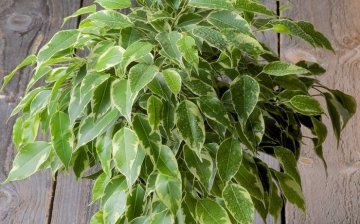
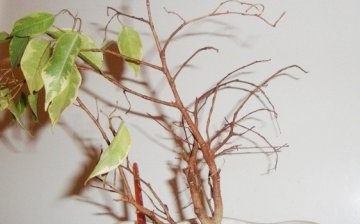

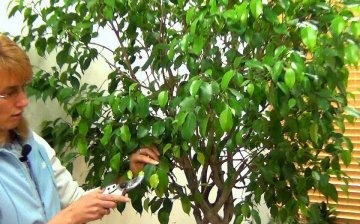





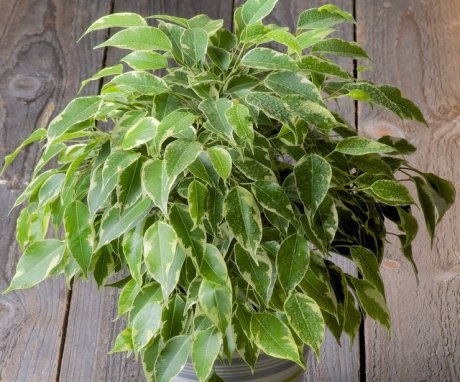
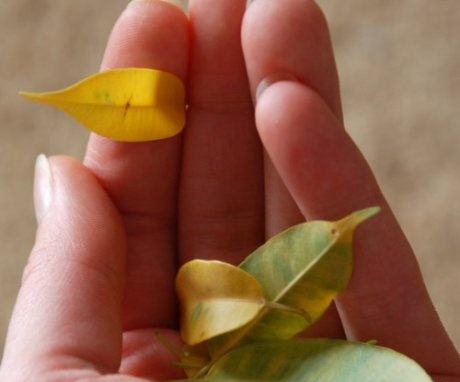
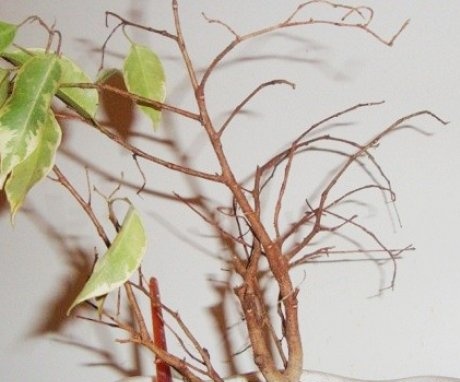

Unfortunately, this is exactly what happened to me. The flower felt great, and then they turned on the heating in the apartment, and he began to shed the leaves. Maybe I started doing something late, but the plant could not be saved. And a friend's in the kitchen. on the floor in a similar apartment and feels great.
From time to time, the ficus also sheds its leaves and immediately begin to take drastic measures - I transplant the flower, spray it abundantly, and also exclude the draft. This usually happens in winter, when it's hot at home, but it's cold outside and I ventilate the room.
My friend's ficus dried up before her eyes and shed most of the leaves. We decided to transplant into new soil, cut off the dried branches, moistened the soil well, washed the remains of the plant and covered it with a large plastic bag. A month later, the plant began to come to life and new leaves appeared on it.